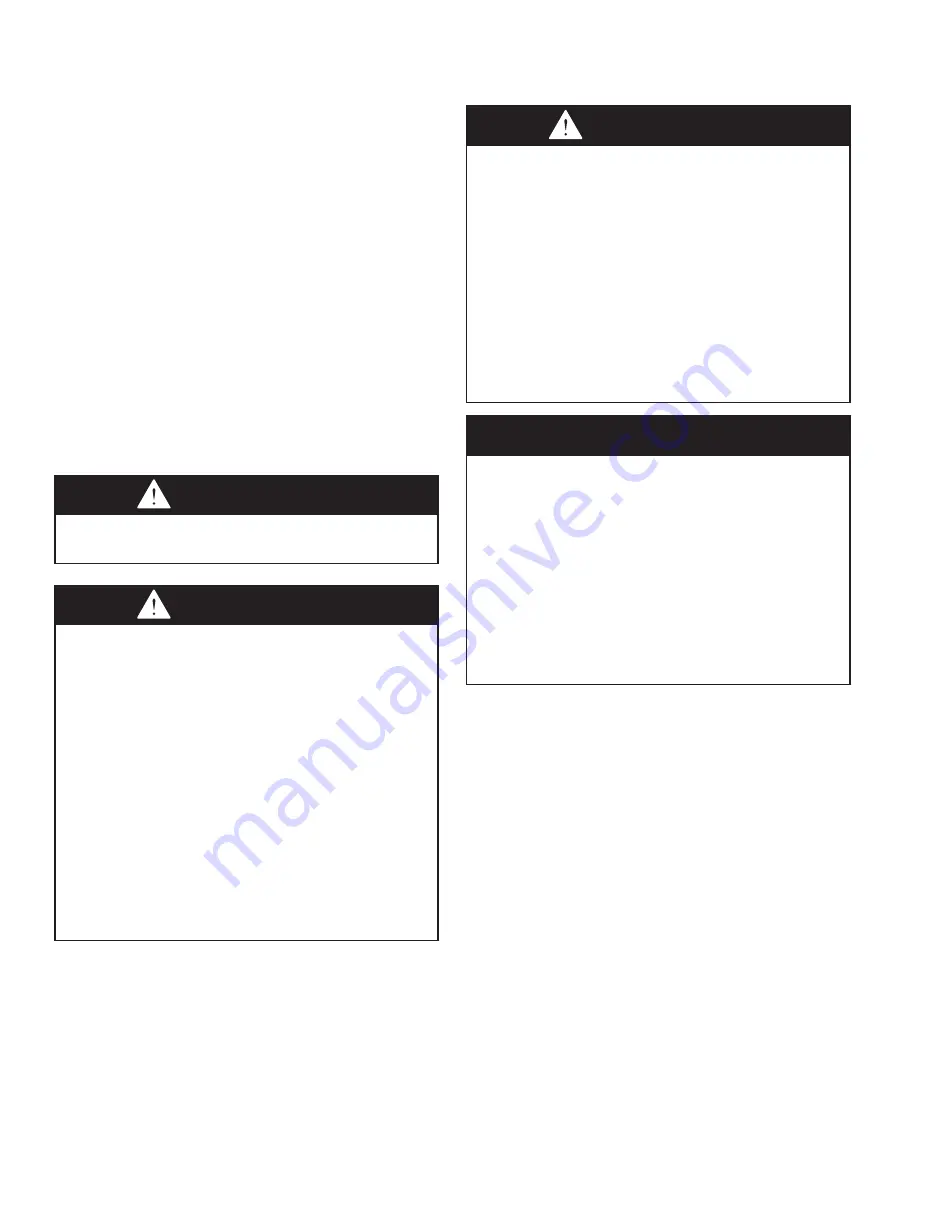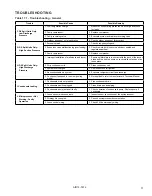
2
AIR14-501.2
SPECIAL PRECAUTIONS
SPECIAL PRECAUTIONS
THE INSTALLATION AND MAINTENANCE INSTRUCTIONS
IN THIS MANUAL MUST BE FOLLOWED TO PROVIDE
SAFE, EFFICIENT, AND TROUBLE-FREE OPERATION. IN
ADDITION, PARTICULAR CARE MUST BE EXERCISED
REGARDING THE SPECIAL PRECAUTIONS LISTED BELOW.
FAILURE TO PROPERLY ADDRESS THESE CRITICAL
AREAS COULD RESULT IN PROPERTY DAMAGE OR LOSS,
PERSONAL INJURY, OR DEATH. THESE INSTRUCTIONS
ARE SUBJECT TO ANY MORE RESTRICTIVE LOCAL OR
NATIONAL CODES.
HAZARD INTENSITY LEVELS
1.
DANGER:
Indicates an imminently hazardous situation
which, if not avoided, WILL result in death or serious injury.
2.
WARNING:
Indicates a potentially hazardous situation which,
if not avoided, COULD result in death or serious injury.
3.
CAUTION:
Indicates a potentially hazardous situation which,
if not avoided, MAY result in minor or moderate injury.
4.
IMPORTANT:
Indicates a situation which, if not avoided, MAY
result in a potential safety concern.
DANGER
Appliances must not be installed where they may be exposed to
potentially explosive or flammable atmosphere.
CAUTION
IMPORTANT
1. Start-up and adjustment procedures should be performed
by a qualified service agency.
2. No water-flow can cause a freeze condition resulting in
damage to the coil.
3. Never leave the unit filled with water in a building without
heat unless antifreeze has been added.
4. All refrigeration checks must be made by a qualified
R-410A refrigeration technician.
5. Do not release refrigerant to the atmosphere. When
adding or removing refrigerant, all national, state/
province, and local laws must be followed.
6. To check most of the Possible Remedies in the
troubleshooting guide listed in Tables 15.1 & 16.1, refer to
the applicable sections of the manual.
Table of Contents
Inspection on Arrival . . . . . . . . . . . . . . . . . . . . . . . . . . . . . . . . . . . . .1
General Information . . . . . . . . . . . . . . . . . . . . . . . . . . . . . . . . . . . . .1
Special Precautions . . . . . . . . . . . . . . . . . . . . . . . . . . . . . . . . . . . . .2
Hazard Intensity Levels . . . . . . . . . . . . . . . . . . . . . . . . . . . . . . . . . .2
SI (Metric) Conversion Factors. . . . . . . . . . . . . . . . . . . . . . . . . . . . .3
Unit Location. . . . . . . . . . . . . . . . . . . . . . . . . . . . . . . . . . . . . . . . . . .3
Handling . . . . . . . . . . . . . . . . . . . . . . . . . . . . . . . . . . . . . . . . . .3
Preparation . . . . . . . . . . . . . . . . . . . . . . . . . . . . . . . . . . . . . . . .3
Drainage . . . . . . . . . . . . . . . . . . . . . . . . . . . . . . . . . . . . . . . . . .3
Electrical . . . . . . . . . . . . . . . . . . . . . . . . . . . . . . . . . . . . . . . . . .3
Installation . . . . . . . . . . . . . . . . . . . . . . . . . . . . . . . . . . . . . . . . . . . 3
Piping Installation . . . . . . . . . . . . . . . . . . . . . . . . . . . . . . . . . . .4
Piping Insulation . . . . . . . . . . . . . . . . . . . . . . . . . . . . . . . . . . . .5
Wiring . . . . . . . . . . . . . . . . . . . . . . . . . . . . . . . . . . . . . . . . . . . .5
Terminal Strip Connections . . . . . . . . . . . . . . . . . . . . . . . . . . . .5
Start-Up Procedure. . . . . . . . . . . . . . . . . . . . . . . . . . . . . . . . . . . . . .6
Pre-Start Checks . . . . . . . . . . . . . . . . . . . . . . . . . . . . . . . . . . . .6
Unit Start-Up Procedure. . . . . . . . . . . . . . . . . . . . . . . . . . . . . . .6
Typical Sequence of Operation . . . . . . . . . . . . . . . . . . . . . . . 7-8
Start-Up Sheet - Example. . . . . . . . . . . . . . . . . . . . . . . . . . . . . . 9-10
Dimensions. . . . . . . . . . . . . . . . . . . . . . . . . . . . . . . . . . . . . . . . 11-12
Technical Data . . . . . . . . . . . . . . . . . . . . . . . . . . . . . . . . . . . . . . . .13
Component Layout . . . . . . . . . . . . . . . . . . . . . . . . . . . . . . . . . . . . .14
Maintenance. . . . . . . . . . . . . . . . . . . . . . . . . . . . . . . . . . . . . . . . . .15
Troubleshooting . . . . . . . . . . . . . . . . . . . . . . . . . . . . . . . . . . . . 16-17
Replacement Parts / Model Nomenclature. . . . . . . . . . . . . . . . . . .18
Serial Plate . . . . . . . . . . . . . . . . . . . . . . . . . . . . . . . . . . . . . . . . . . .19
Warranty . . . . . . . . . . . . . . . . . . . . . . . . . . . . . . . . . . . . . . . . . . . . .20
WARNING
1. Disconnect power supply before making wiring
connections to prevent electrical shock and equipment
damage.
2. All appliances must be wired strictly in accordance with
the wiring diagram furnished with the appliance. Any
wiring different from the wiring diagram could result in a
hazard to persons and property.
3. Any original factory wiring that requires replacement must
be replaced with wiring material having a temperature
rating of at least 105°C.
4. Ensure that the supply voltage to the appliance, as
indicated on the serial plate, is not 5% greater than rated
voltage.
5. When servicing or repairing this equipment, use only
factory-approved service replacement parts. Refer to
the rating plate on the appliance for complete appliance
model number, serial number, and company address.
Any substitution of parts or controls not approved by the
factory will be at the owner’s risk.
1. Ensure that the supply voltage to the appliance, as
indicated on the serial plate, is not 5% less than the rated
voltage.
2. Units not approved for use in potable water systems.
3. Hot water supplied to the hot water heating option must
not exceed 200°F temperature or 125 PSIG pressure.
4. Do not operate the units within steam pressure greater
than 10 PSIG. Steam pressure must be 10 PSIG or lower
to avoid excessive discharge air temperatures that could
cause burns or personal injury.
5. Do not overcharge the refrigeration system. This can lead
to elevated compressor discharge pressure and possibly
flooding the compressor with liquid.
6. Do not attempt to reuse any mechanical or electrical
component which has been wet. Such component must
be replaced.



































